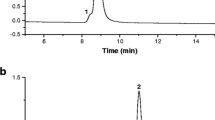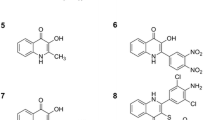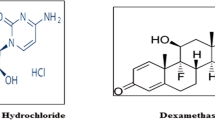Abstract
The determination of cellular content of octadecylphosphocholine (D-19391) and hexadecylphosphocholine (HePC, D-18506), two anticancer agents of the alkylphosphocholine group, using capillary gas chromatography is described. The compounds' cytotoxicity was first determined by the MTI [3-(4,5-dimethyl-2-thiazolyl)-2,5-diphenyltetrazolium] assay, being indicative for the concentration used in the uptake and retention measurements. D-19391 was added to the SK-BR-3 breast cancer cell line and HePC to the Molt-4 leukemia cell line in concentrations of, respectively, 18.6 and 15.0 μM, during a 36-h incubation period at 37°C, 5% CO2. HePC uptake in the leukemia cells was followed by a 24-h reversibility test in drug-free medium. Subsequently, sample clean-up was performed on a weak cation-exchange column. For the quantitative analysis, HePC was used as internal standard for the D-19391 measurements and vice versa. Derivatization of the samples with trimethylsilylbromide was followed by capillary gas chromatographic analysis. From these data we conclude that our uptake results are quite similar with those of a previous study of HePC cellular uptake in the more resistant Coco-2T colon cancer cell line. Without having investigated the mechanism that underlies the cellular uptake results obtained, our study points to no direct correlation between the compounds' cellular uptake and their cytotoxic effects.
Similar content being viewed by others
Abbreviations
- ALP:
-
alkyllysophospholipid
- APC:
-
alkylphosphocholine
- CBA:
-
carboxylic acid
- cGC:
-
cabillary gas chromatography
- D-19391:
-
octadecylphosphocholine
- FBS:
-
fetal bovine serum
- HePC:
-
hexadecylphosphocholine (D-18506)
- ID50 :
-
50% inhibitory concentration
- MTT:
-
3-(4,5-dimethyl-2-thiazolyl)-2,5-diphenyl-tetrazolium
- OD:
-
optical density
References
Unger, C., and Eibl, H. (1991) Hexadecylphosphocholine: Preclinical and the First Clinical Results of a New Antitumor Drug. Lipids 26, 1412–1417.
Unger, C., Sindermann, H., Peukert, M., Hilgard, P., Engel, J., and Eibl, H. (1992) Hexadecylphosphocholine in the Topical Treatment of Skin Metastases in Breast Cancer Patients, Prog. Exp. Tumor Res. 34, 153–159.
Berdel, W.E. (1991) Membrane Interactive Lipids as Experimental Anticancer Drugs, Br. J. Cancer 64, 208–211.
Lohmeyer, M., and Bittman, R. (1994) Antitumour Ether Lipids and Alkylphosphocholines, Drugs of the Future 19, 1021–1037.
Houlihan, W.J., Lohmeyer, M., Workman, P., and Cheon, W.H. (1995) Phospholipid Antitumor Agents, Med. Res. Rev. 15, 157–223.
Grunicke, H.H. (1991) The Cell Membrane as a Target for Cancer Chemotherapy, Eur. J. Cancer 27, 281–284.
Modollel, M., Andreesen, R., Pahlke, W., Brugger, U., and Munder, P.G. (1979) Disturbance of Phospholipid Metabolism During the Selective Destruction of Tumor Cells Induced by Alkyllysophospholipids, Cancer Res. 39, 4681–4686.
Überall, F., Oberhuber, H., Maly, K., Zaknun, J., Demuth, L., and Grunicke, H.H. (1991) Hexadecylphosphocholine Inhibits Inositol Phosphate Formation and Protein Kinase C Activity, Cancer Res. 51, 807–812.
Powis, G., Seewald, M.J., Gratas, C., Melder, D., Riebow, J., and Modest, E.J. (1992) Selective Inhibition of Phosphatidylinositol Phospholipase C by Cytotoxic Ether Lipid Analogues, Cancer Res. 52, 2835–2840.
Schallier, D.C., Bruyneel, E.A., Storme, G.A., Hilgard, P., and Mareel, M.M. (1991) Antiinvasive Activity of Hexadecylphosphocholine in vitro, Anticancer Res. 11, 1285–1292.
Principe, P., Sidoti, C, and Braquet, P. (1992) Tumor Cell Kinetics Following Antineoplastic Ether Phospholipid Treatment. Cancer Res. 52, 2509–2515.
Diomede, L., Colotta, F., Piovani, B., Fabio, R.E., Modest, E.J., and Salmona, M. (1993) Induction of Apoptosis in Human Leukemic Cells by the Ether Lipid 1-Octadecyl-2-Methyl-rac-Glycero-3-Phosphocholine. A Possible Basis for its Selective Action, Int. J. Cancer 53, 124–130.
Coene, J., Van den Eeckhout, E., and Herdewijn, P. (1993) Gas Chromatographic Determination of Alkyllysophospholipids After Solid-Phase Extraction from Cell Culture Media, J. Chromatogr. 612, 21–26.
Brochez, V., and Van den Eeckhout, E., (1998) Effect of Cell Density on Cellular Uptake of Hexadecylphosphocholine in the SK-BR-3 Breast Cancer Cell Line, Drugs Today, in press.
Steelant, W.F.A., Bruyneel, E.A., Mareel, M.M., and Van den Eeckhout, E.G. (1995) Capillary Gas Chromatography of Hexadecylphosphocholine in Caco-2T Cells and Cell Culture Media. Anal. Biochem. 227, 246–250.
Romijn, J.C., Verkoelen, F.C., Schroeder, F.H. (1988) Application of the MTT Assay to Human Prostate Cancer Cell Lines in vitro: Establishment of Test Conditions and Assessment of Hormone-Stimulated Growth and Drug-Induced Cytostatic and Cytotoxic Effects, Prostate 12, 99–110.
Fleer, E.A.M., Berkovic, D., Eibl, H., and Unger, C. (1993) Investigation on the Cellular Uptake of Hexadecylphosphocholine, Lipids 28, 731–736.
Peterson, E.S., Kelley, E.E., Modest, E.J., and Burns, C.P. (1992) Membrane Lipid Modification and Sensitivity of Leukemic Cells to the Thioether Lipid Analogue BM 41.440, Cancer Res. 52, 6263–6269.
Kelley, E.E., Modest, E.J., and Burns, C.P. (1993) Unidirectional Membrane Uptake of the Ether Lipid Antineoplastic Agents Edelfosine by L1210 Cells, Biochem. Pharmacol. 45, 2435–2439.
Bazill, G.W., and Dexter, T.M. (1990) Role of Endocytosis in the action of Ether Lipids on WEHI-3B, HL60, and FDCP-mix A4 Cells, Cancer Res. 50, 7505–7512.
Author information
Authors and Affiliations
Corresponding author
About this article
Cite this article
Brochez, V., Van Heuverswyn, D., Diniz, J.A.D.B.N.F. et al. Cellular uptake and retention measurements of alkylphosphocholines in the SK-BR-3 breast cancer and molt-4 leukemia cell line using capillary gas chromatography. Lipids 34, 511–516 (1999). https://doi.org/10.1007/s11745-999-0392-6
Received:
Revised:
Accepted:
Issue Date:
DOI: https://doi.org/10.1007/s11745-999-0392-6




